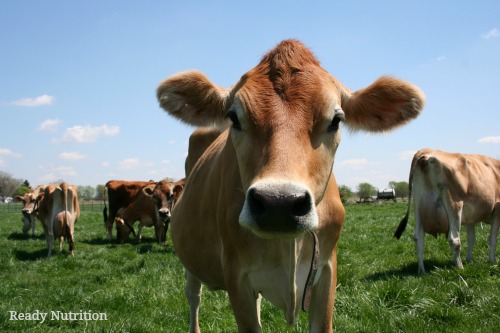
- Belted Galloway
- Dexter
- Jersey
- Panda Cow
- Hereford
- Lowline angus
- Texas Longhorn
- Miniature Highland
- Holstein
As well, this book goes over some of the benefits of miniatures of all types and how they can be beneficial to your homestead.
- Space: Okay, so it’s abundantly clear that dairy cows are big, but let’s talk about the size difference between a mini and a traditional cow. Minis range in size at three years of age from 36″ in height to a maximum of 48″. This is one-half to one-third the size of normal cattle. A traditional dairy cow can weigh over 1300 pounds and stands close to 5 feet tall. A mini-Jersey breed, on the other hand, weighs about 400-500 pounds and is about 3 feet tall. A smaller cow means a smaller space commitment (for both housing and grazing) overall—suddenly, the idea of having a dairy cow becomes feasible even for people with small homesteads.
- Feed Conversion: These petite cows need only half an acre for grazing and a third of a ton of feed per year (as opposed to full-sized counterparts who need more than a ton of feed per year), yet minis still produce 50-75% as much milk as the bigger cows. This makes the feed conversion rate outstanding and efficient for a smaller farm or homestead.
- Safer for families: The sheer size of a typical dairy cow means many precautions need to be taken to handle the animals. Younger kids who might otherwise be intimidated by a regular-sized cow can help with the daily care/maintenance of a mini. Children should, of course, always be supervised around livestock, but a cow the size of a large dog is definitely a safer bet for those with families.
- Gentle nature: It’s more than only size that makes mini cows so easy to handle and get along with—they are particularly docile and gentle. They do less damage to pastures/fences when they walk, and many owners compare them in nature to golden retrievers.
Initial cost may be the only downside to owning mini cows—they can be $1,000-$2,000 more than a traditional dairy cow; however, when you do the math, the investment into feed + dairy output + accommodations over time likely still make minis worth it for your family. Adding another layer of self-reliance to your homestead is always beneficial, as we never know what the future holds, and for those nervous about making the leap to “farmer,” the mini cow could be a great first step.

My cattle would starve on the rations you describe, even with summer pasture. Yes they are full size cattle, and like sharks they are eating machines, only herbivores. With the cost of mini’s so high, it would probably be better to get a goat at a fraction of the cost, if one is up to the challenge of keeping it confined.
Also, where would one find a mini bull to use, or sperm for AI? Without large AI companies like ABS stocking mini sperm, what minimum could be purchased and how expensive to store in a costly nitrogen container?
It would be probably more prudent to consider a smaller breed of cattle (like Jersey rather than Holstein) that is represented in your area.